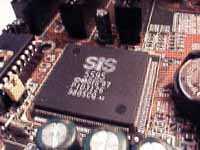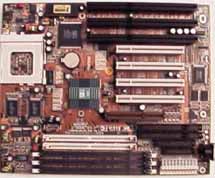MTech R581-A SiS 5591 Socket-7 Board
by Anand Lal Shimpi on March 14, 1998 5:41 PM EST- Posted in
- Motherboards
In the second half of 1997, MTech announced the first real successor to the original Mustang, the MTech Mustang Ultra, which was a SiS 5582/5598 based motherboard solution. While many expected the same sort of performance out of that motherboard, what wasn't clear was MTech's belief of the target market for such a motherboard. Speaking practically, the SiS 5582/5598 chipsets are no more than cheap TX clones, although the 5582 is a great performer, and although the 5598 does offer built in video, no motherboard based on either of those two chipsets could possibly match the performance of a true TX competitor.
The MTech Mustang Ultra went relatively un-noticed, although this appeared to be odd to many that followed the development of the motherboard, it makes much sense now, looking at the real successor to the throne of the original MTech Mustang, the MTech Mustang-AGP R581-A. The name may be a mouthful, but such a name is fitting, since there's a mouthful to say about this motherboard...good? bad? Let's find out.
| Socket Style: | Socket-7 |
| Chipset: | SiS 5591 |
| Cache: | 1024KB |
| Form Factor: | AT (w/ AT & ATX PS Connectors) |
| BUS Speeds: | 60 / 66 / 68 / 75 / 83 / 90 / 100 MHz |
| Clock Multipliers: | 1.5x / 2.0x / 2.5x / 3.0x / 3.5x / 4.0x / 4.5x |
| Voltages Supported: | 2.1v - 3.5v in 0.1v increments |
| RAM Slots: | 2 72pin SIMM
Slots 3 168pin DIMM Slots |
| AGP/PCI/ISA Slots: | 1 AGP Slot 4 PCI Slots 3 ISA Slots (1 Shared) |
| BIOS: | AWARD PnP BIOS |
| PCI EIDE Controller: | Super I/O 2 EIDE Channels 1 FDD Channel 2 Serial /1 EPP |
| When most users think about MTech motherboards, they think about low-cost alternatives to the AOpens, ASUSes, and Supermicro's of the market, the MTech Mustang-AGP R581-A puts an end to that stereotype. The motherboard is outfitted with 15 mid-sized capacitors, 4 toroids to complement the 4 switching voltage regulators, fitted frames on all of the EIDE/FDD/Serial connectors, and the nostalgic green SiS heatsink on the 5591 chipset. |  |
| The two chip solution that makes up the SiS 5591 chipset (5591 and 5595 chips) is much like that of Intel's TX chipset with three major differences: 1) With 1MB of L2 cache, the chipset caches a full 256MB of RAM compared to the 64MB cacheable memory area of the TX chipset, 2) the 5591 adds AGP support to the outstanding design and stability of R581-A, and 3) the 5591 chipset allows for asynchronous operation of the PCI/AGP buses at higher memory bus speeds, meaning the PCI/AGP buses will operate at or around 33/66MHz respectively regardless of the system bus speed you select. Officially the SiS 5591 chipset does not support any bus speeds above the 83.3MHz frequency, however the R581-A can be taken up to a 90MHz and 100MHz frequency via two undocumented settings. Here is a small table documenting all the jumper settings for bus speeds as well as the PCI/AGP frequencies at those speeds: |  |
| Bus Speed | PCI | AGP | Jumper Setting JP1, JP2, JP3 |
| 60MHz | 30 | 60 | 2-3, 2-3, 2-3 |
| 66MHz | 33 | 66 | 1-2, 2-3, 2-3 |
| 68.5MHz | 34 | 68 | 2-3, 2-3, 1-2 |
| 75MHz | 32 | 64 | 2-3, 1-2, 2-3 |
| 75MHz2 | 37 | 75 | 1-2, 2-3, 1-2 |
| 83MHz | 32 | 64 | 2-3, 2-3, 1-2 |
| 90MHz | 30 | 60 | 2-3, 1-2, 1-2 |
| 100MHz | 33 | 66 | 1-2, 1-2, 1-2 |
| The motherboard's expandability features put some of the newly announced Socket-7 AGP motherboards to shame, especially since the R581-A is an AT motherboard. Featuring 3 DIMM, and 2 SIMM slots the R581-A can cater to almost anyone's needs, however for most users making a clean upgrade there is little use for the 2 SIMM slots, for those of you that have yet to upgrade to SDRAM the SIMM slots can help you drag out your purchases for a little while longer. |  |
The Mustang R581-A comes packaged with the best user's manual ever shipped with a MTech motherboard, 2 SiS 5591 driver disks, the first including the SiS AGP Gart VXD and the SiS Bus Master drivers, and the second containing the SiS 5591 Hardware Monitoring utility for Windows 95. The SiS Hardware Monitoring Utility is remarkably useful compared to the other "hardware monitoring utilities" that are packaged with motherboards today, again it is quite obvious that the R581-A isn't an "el-cheapo" motherboard.
Setting up the R581-A wasn't all too bad, the jumpers on the motherboard itself were much easier to configure than previous MTech boards, all of them falling in easy to reach areas of the board, left unobstructed by any other components. The motherboard does feature a proprietary 3 pin CPU fan connector, and a hardware monitoring IC in the center of the CPU socket to make the R581-A fall into full control of the user. The BIOS setup utilities of most non-Intel chipset based motherboards tend to be stripped bare of any tweakable settings, however this is not the case of the SiS 5591 on the R581-A, the Chipset Features Settings of the Award BIOS on the Mustang-AGP included settings found on very few motherboards, which allows the test system to be completely optimized for performance.
Upon booting Windows 95 for the first time, the SiS 5595 HDD Controller was detected as a "PCI Card," in spite of that both IDE channels were left completely operational, leaving the AOpen 24X CD-ROM drive and the Western Digital Caviar test drive at 100% functionality. Installing the SiS BMIDE Drivers and the Gart VXD posed very few problems, in most cases it'll be a rare occasion that you experience many problems provided you perform a clean install of your OS software.
The performance of the R581-A is purely amazing, especially for a SiS based motherboard. This time around the strengths of the Mustang don't lie in the world of the 6x86MX, instead the Mustang-Ultra's power is harnessed almost completely by the Pentium MMX and K6 processors, not to say that the board doesn't scream with a 6x86MX...it just performs extremely well with other processors in addition to that. The Pentium MMX made it up to 315MHz (90MHz x 3.5) on the R581-A, unfortunately Winstone would not complete a test-run without crashing at that high of a speed. The probable cause for that being heat, the AMD K6 made it as far as 250MHz without any problems, and the 6x86MX-200+ was clocked up to 180MHz (90MHz x 2.0) while not producing even the slightest hiccup.
While the R581-A is the perfect candidate for the K6-266, supporting both the 2.2v core voltage and the 4.0x clock multiplier, its future with the K6-3D is shady...why? Keep on reading...










0 Comments
View All Comments